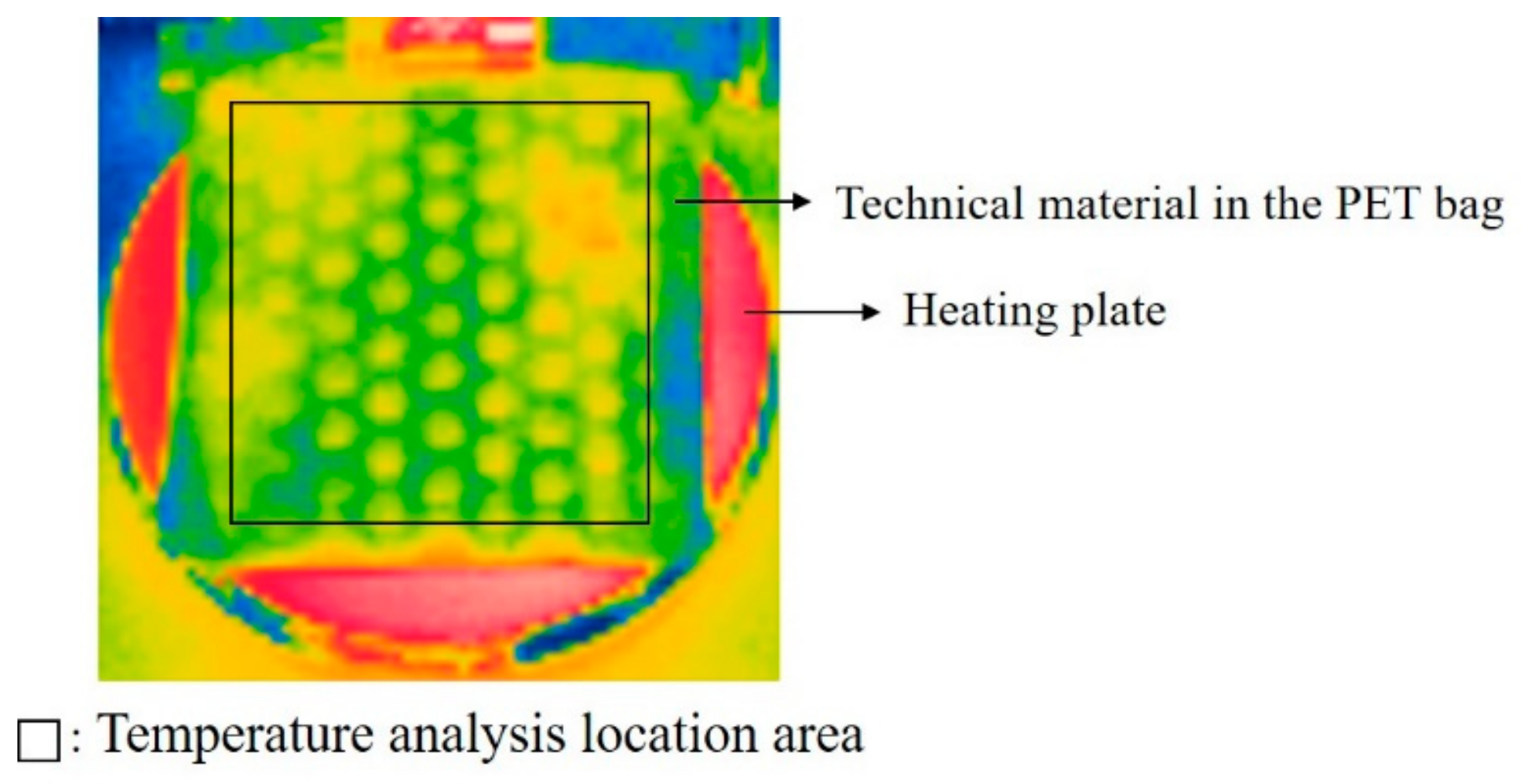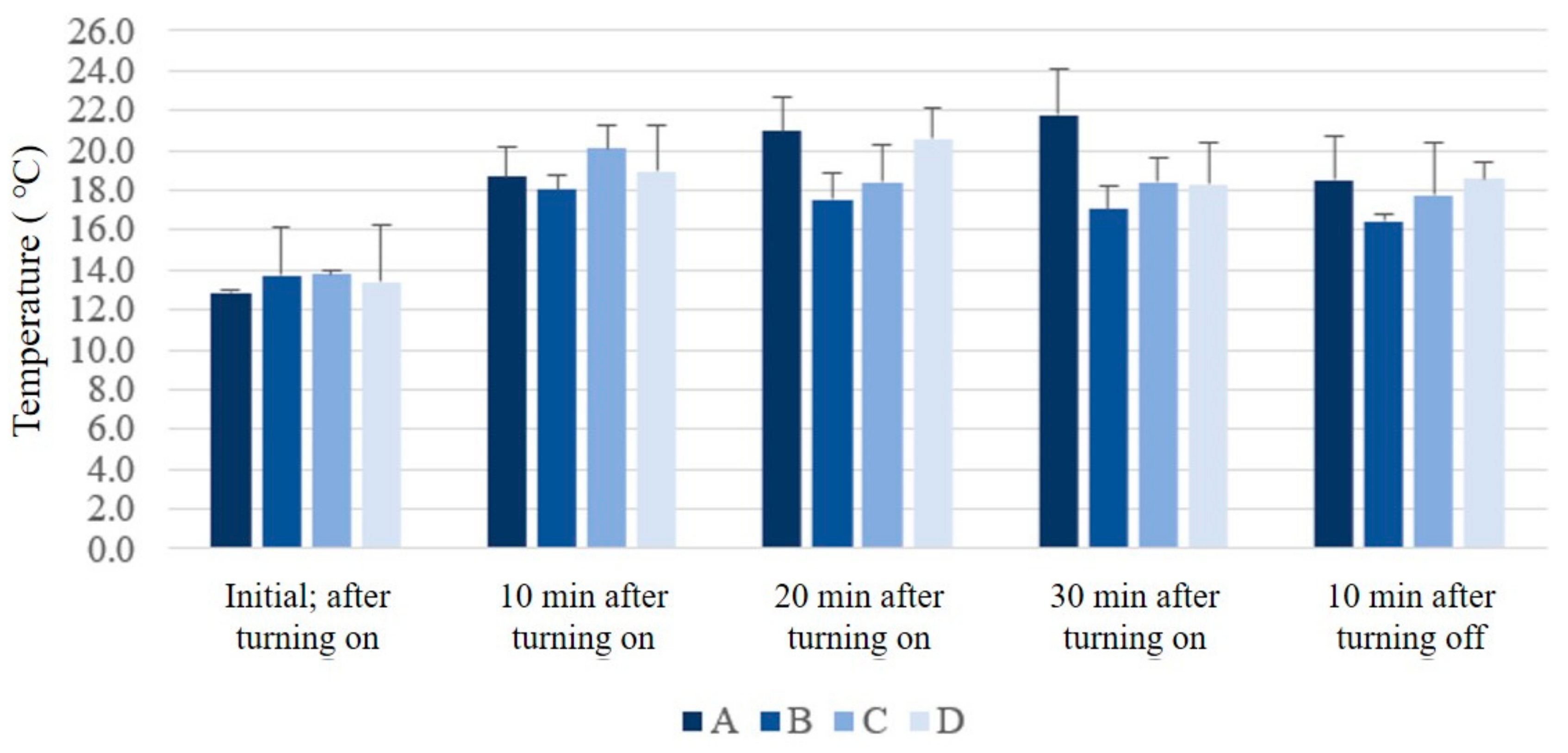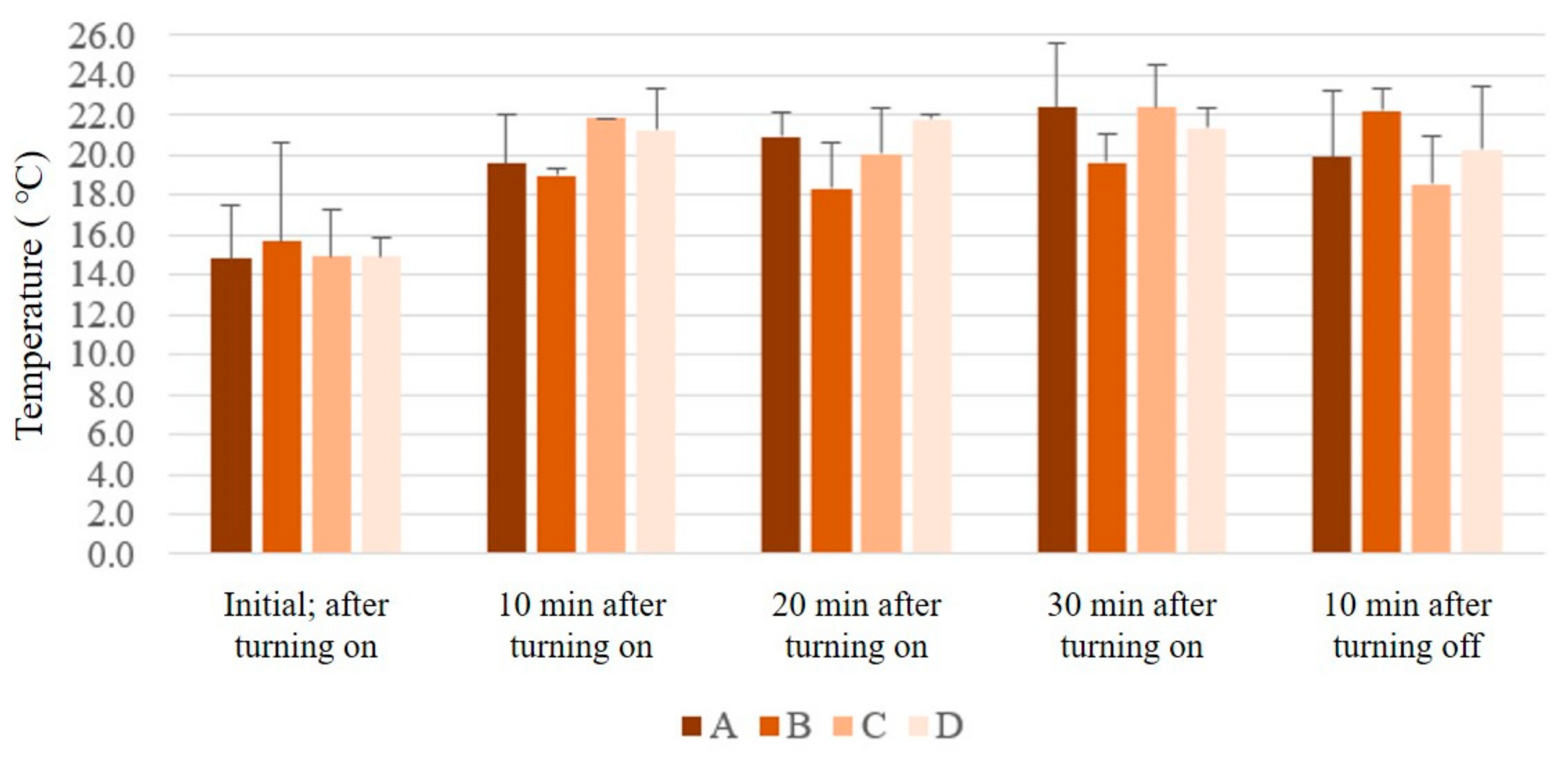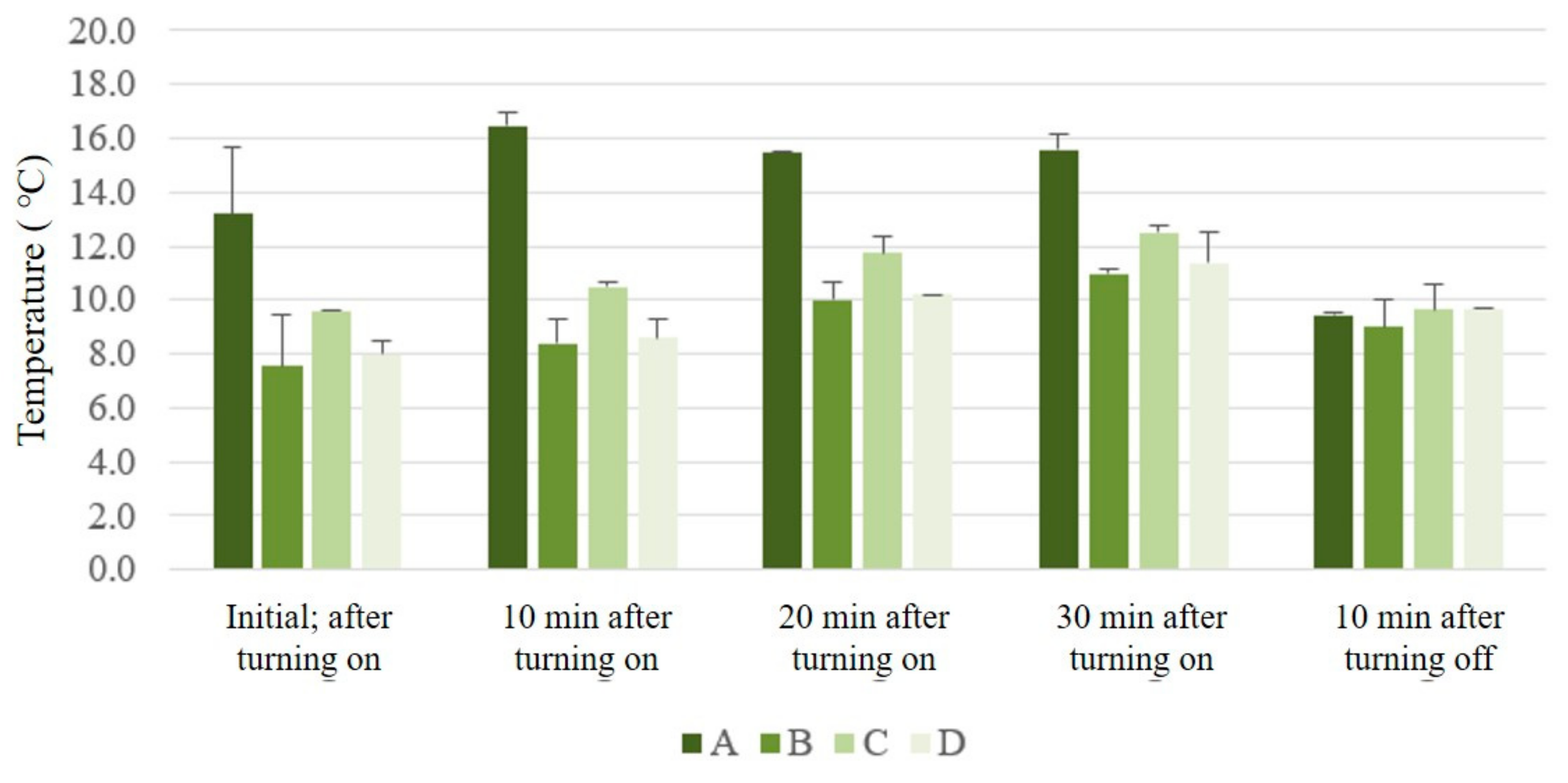Evaluation of Thermal Properties of 3D Spacer Technical Materials in Cold Environments using 3D Printing Technology
Abstract
1. Introduction
2. Materials and Methods
2.1. 3D Modeling of Materials
2.2. 3D Printing of Materials
2.3. Temperature Measurement Analysis
3. Results and Discussion
3.1. Technical Material Surface and Internal Temperature Measurement
3.2. Overall Surface Temperature Distribution of the Technical Materials
4. Conclusions
Author Contributions
Funding
Acknowledgments
Conflicts of Interest
References
- Havenith, G. Heat balance when wearing protective clothing. Ann. Occup. Hyg. 1999, 43, 289–296. [Google Scholar] [CrossRef]
- Holcombe, B.V.; Hoschke, B.N. Dry heat transfer characteristics of underwear fabrics. Text. Res. J. 1983, 53, 368–374. [Google Scholar] [CrossRef]
- Behera, B.K.; Ishtiaque, S.M.; Chand, S. Comfort properties of fabrics woven from ring-, rotor-, and friction-spun yarns. J. Text. Inst. 1997, 88, 255–264. [Google Scholar] [CrossRef]
- Frydrych, I.; Dziworska, G.; Bilska, J. Comparative analysis of the thermal insulation properties of fabrics made of natural and man-made cellulose fibres. Fibres Text. East. Eur. 2002, 10, 40–44. [Google Scholar]
- Öner, E.; Okur, A. Thermophysiological comfort properties of selected knitted fabrics and design of T-shirts. J. Text. Inst. 2015, 106, 1403–1414. [Google Scholar] [CrossRef]
- Atasağun, H.G.; Öner, E.; Okur, A.; Beden, A.R. A comprehensive study on the general performance properties of Viloft-blended knitted fabrics. J. Text. Inst. 2015, 106, 523–535. [Google Scholar] [CrossRef]
- Abreu, M.J. An investigation of the thermal comfort behaviour for active wear using a thermal manikin. In Proceedings of the 7th International Thermal Manikin and Modelling Meeting, Coimbra, Portugal, 2–5 September 2008. [Google Scholar]
- Ho, C.; Fan, J.; Newton, E.; Au, R. Effects of athletic T-shirt designs on thermal comfort. Fibers Polym. 2008, 9, 503–508. [Google Scholar] [CrossRef]
- Mert, E.; Böhnisch, S.; Psikuta, A.; Bueno, M.A.; Rossi, R.M. Contribution of garment fit and style to thermal comfort at lower body. Int. J. Biometeorol. 2016, 60, 1995–2004. [Google Scholar] [CrossRef]
- Wang, F.; Shi, W.; Lu, Y.; Song, G.; Rossi, R.M.; Anaheim, S. Effects of moisture content and clothing fit on clothing apparent ‘wet’ thermal insulation: a thermal manikin study. Text. Res. J. 2016, 86, 57–63. [Google Scholar] [CrossRef]
- Cubric, I.S.; Skenderi, Z.; Havenith, G. Impact of raw material, yarn and fabric parameters, and finishing on water vapor resistance. Text. Res. J. 2013, 83, 1215–1228. [Google Scholar] [CrossRef]
- Voelker, C.; Hoffmann, S.; Komadt, O.; Arens, E.; Zhang, H. Heat and moisture transfer through clothing. In Proceedings of the 11th International IBPSA Building Simulation Conference, Glasgow, Scotland, 27–30 July 2009. [Google Scholar]
- Rhie, J. A Study on the Thermal Resistivity of the Body-Clothing-Ambient System, 1984. Ewha Womans University. Available online: http://www.riss.kr/search/detail/DetailView.do?p_mat_type=be54d9b8bc7cdb09&control_no=79f48fcb981c0e55#redirect (accessed on 2 September 2019).
- Das, A.; Alagirusamy, R.; Kumar, P. Study of heat transfer through multilayer clothing assemblies: A theoretical prediction. AUTEX Res. J. 2011, 11, 54–60. [Google Scholar]
- Shen, H.; Yokoyama, A.; Sukigara, S. Modeling of heterogeneous heat transfer in fabrics. Text. Res. J. 2018, 88, 1164–1172. [Google Scholar] [CrossRef]
- Wilson, C.A.; Laing, R.M.; Carr, D.J. Air and air spaces—The invisible addition to thermal resistance. J. Hum. Environ. Syst. 2002, 5, 69–77. [Google Scholar] [CrossRef][Green Version]
- Psikuta, A.; Frackiewicz-Kaczmarek, J.; Frydrych, I.; Rossi, R. Quantitative evaluation of air gap thickness and contact area between body and garment. Text. Res. J. 2012, 82, 1405–1413. [Google Scholar] [CrossRef]
- Chen, Y.S.; Fan, J.; Qian, X.; Zhang, W. Effect of garment fit on thermal insulation and evaporative resistance. Text. Res. J. 2004, 74, 742–748. [Google Scholar] [CrossRef]
- Weder, M.S.; Zimmerli, T.; Rossi, R.M. A Sweating and Moving Arm for the Measurement of Thermal Insulation and Water Vapour Resistance of Clothing. In Performance of Protective Clothing; Johnson, J.S., Mansdorf, S.Z., Eds.; ASTM: West Conshohocken, PA, USA, 1996; pp. 257–268. [Google Scholar]
- Song, M.; Kwon, M. A Study on the thermal characteristics of comfortable heat-retaining winter clothing. J. Korean Soc. Costume 2008, 58, 24–34. [Google Scholar]
- Wieme, T.; Duan, L.; Mys, N.; Cardon, L.; D’hooge, D.R. Effect of Matrix and Graphite Filler on Thermal Conductivity of Industrially Feasible Injection Molded Thermoplastic Composites. Polymers 2019, 11, 87. [Google Scholar] [CrossRef] [PubMed]
- Duan, L.; D’hooge, D.R.; Spoerk, M.; Cornillie, P.; Cardon, L. Facile and low-cost route for sensitive stretchable sensors by controlling kinetic and thermodynamic conductive network regulating strategies. ACS Appl. Mater. Interfaces 2018, 10, 22678–22691. [Google Scholar] [CrossRef]
- Wondu, E.; Lule, Z.; Kim, J. Thermal Conductivity and Mechanical Properties of Thermoplastic Polyurethane-/Silane-Modified Al2O3 Composite Fabricated via Melt Compounding. Polymers 2019, 11, 1103. [Google Scholar] [CrossRef]
- Mao, N.; Russell, S.J. The thermal insulation properties of spacer fabrics with a mechanically integrated wool fiber surface. Text. Res. J. 2007, 77, 914–922. [Google Scholar] [CrossRef]
- Abounaim, M.D.; Diestel, O.; Hoffmann, G.; Cherif, C. Thermoplastic composites from curvilinear 3D multi-layer spacer fabrics. J. Reinf. Plast. Comp. 2010, 29, 3554–3565. [Google Scholar] [CrossRef]
- Chen, S.; Long, H.R.; Liu, Y.H.; Hu, F.C. Mechanical properties of 3D-structure composites based on warp-knitted spacer fabrics. Autex Res. J. 2015, 15, 127–137. [Google Scholar] [CrossRef]
- Yip, J.; Ng, S.P. Study of three-dimensional spacer fabrics: Physical and mechanical properties. J. Mater. Process. Tech. 2008, 206, 359–364. [Google Scholar] [CrossRef]
- Lee, H.; Eom, R.; Lee, Y. Physical property evaluation of 3D knitted spacer fabrics for functional wear. Text. Sci. Eng. 2017, 54, 292–299. [Google Scholar]
- Li, S.; Qin, J.; Wang, B.; Zheng, T.; Hu, Y. Design and Compressive Behavior of a Photosensitive Resin-Based 2-D Lattice Structure with Variable Cross-Section Core. Polymers 2019, 11, 186. [Google Scholar] [CrossRef]
- Mpofu, N.S.; Mwasiagi, J.I.; Nkiwane, L.C.; Njuguna, D. Use of regression to study the effect of fabric parameters on the adhesion of 3D printed PLA polymer onto woven fabrics. Fash. Text. 2019, 6, 24. [Google Scholar] [CrossRef]
- Han, Y.; Kim, J. A study on the mechanical properties of knit fabric using 3D printing-Focused on PLA, TPU Filament. J. Fash. Bus. 2018, 22, 93–205. [Google Scholar]
- Song, H. Study on the textile structural design using SLS 3D printing technology-Focused on design of flexible woven fabric structure. J. Fash. Bus. 2019, 23, 67–84. [Google Scholar]
- Kim, H.; Kang, I. Study on status of utilizing 3D printing in fashion field. J. Korea Fash. Costume Des. Assoc. 2015, 17, 125–143. [Google Scholar]
- Kim, S.; Seong, H.; Her, Y.; Chun, J. A study of the development and improvement of fashion products using a FDM type 3D printer. Fash. Text. 2019, 6, 9. [Google Scholar] [CrossRef]
- Wang, S.; Capoen, L.; D’hooge, D.R.; Cardon, L. Can the melt flow index be used to predict the success of fused deposition modelling of commercial poly (lactic acid) filaments into 3D printed materials? Plast. Rubber Compos. 2018, 47, 9–16. [Google Scholar] [CrossRef]
- Plastics—Determination of Tensile Properties—Part 2: Test Conditions for Moulding and Extrusion Plastics; ISO 527-2:2012; International Organization for Standardization: Geneva, Switzerland, 2017.
- Choi, J.; Kim, M. Clothing and Health; Kyomunsa: Gyeonggi Province, Korea, 2011. [Google Scholar]
- Choi, H. Thermal comfort and the insulation of clothing. SAREK 1987, 16, 243–247. [Google Scholar]
- Ziaei, M.; Ghane, M. Thermal insulation property of spacer fabrics integrated by ceramic powder impregnated fabrics. J. Ind. Text. 2013, 43, 20–33. [Google Scholar] [CrossRef]
- Lee, B.; Hong, K.; Lee, Y. The change of clothing insulation and surface temperature measured by thermography with the ease of pattern. KJHE 2010, 19, 1045–1052. [Google Scholar] [CrossRef]
- Lee, H.; Eom, R.; Jeong, Y.; Lee, Y. Thermal insulation analysis of man’s vest in terms of fit and armhole depth. J. KSLES. 2014, 21, 145–157. [Google Scholar] [CrossRef]
- Li, J.L.; Zhang, Z.; Wang, Y. The relationship between air gap sizes and clothing heat transfer performance. J. Text. Inst. 2013, 104, 1327–1336. [Google Scholar] [CrossRef]
- Song, G. Clothing air gap layers and thermal protective performance in single layer garment. J. Ind. Text. 2007, 36, 193–205. [Google Scholar] [CrossRef]
- Lotens, W.A. The actual insulation of multilayer clothing. Scand. J. Work Environ. Health 1989, 15, 66–75. [Google Scholar]
- Han, Y.; Kim, J. Study on peel strength measurement of 3D printing composite fabric by using FDM. J. Fash. Bus. 2019, 23, 77–88. [Google Scholar]








| Material Design | Side Width (Unit: cm) | Leg Height (Unit: cm) | Pore Size (Unit: cm) |
|---|---|---|---|
| A | 0.2 | 0.5 | 0.9 |
| B | 0.2 | 1.5 | 0.9 |
| C | 0.5 | 0.5 | 0.6 |
| D | 0.5 | 1.5 | 0.6 |
| Specifications of TPU | |
|---|---|
| Print temperature | 210–235 °C |
| Baseplate temperature | 50–75 °C |
| Heat deflection temperature | 85–110 °C |
| Melt flow index | 14–28 g/10 min |
| Tensile yield strength | 21–36 MPa |
| Elongation at break | 26–60% |
| Flexural strength | 60–97 MPa |
| Flexural modulus | 1.8–3.0 G/Pa |
| Impact strength | 120 kJ/m2 |
| Filament diameter | 1.75 mm (±0.05 mm) |
| Heating Plate Condition | A | B | C | D |  |
| Initial; after turning on |  |  |  |  | |
| 10 min after turning on |  |  |  |  | |
| 20 min after turning on |  |  |  |  | |
| 30 min after turning on |  |  |  |  | |
| 10 min after turning off |  |  |  |  |
© 2019 by the authors. Licensee MDPI, Basel, Switzerland. This article is an open access article distributed under the terms and conditions of the Creative Commons Attribution (CC BY) license (http://creativecommons.org/licenses/by/4.0/).
Share and Cite
Eom, R.-i.; Lee, H.; Lee, Y. Evaluation of Thermal Properties of 3D Spacer Technical Materials in Cold Environments using 3D Printing Technology. Polymers 2019, 11, 1438. https://doi.org/10.3390/polym11091438
Eom R-i, Lee H, Lee Y. Evaluation of Thermal Properties of 3D Spacer Technical Materials in Cold Environments using 3D Printing Technology. Polymers. 2019; 11(9):1438. https://doi.org/10.3390/polym11091438
Chicago/Turabian StyleEom, Ran-i, Hyojeong Lee, and Yejin Lee. 2019. "Evaluation of Thermal Properties of 3D Spacer Technical Materials in Cold Environments using 3D Printing Technology" Polymers 11, no. 9: 1438. https://doi.org/10.3390/polym11091438
APA StyleEom, R.-i., Lee, H., & Lee, Y. (2019). Evaluation of Thermal Properties of 3D Spacer Technical Materials in Cold Environments using 3D Printing Technology. Polymers, 11(9), 1438. https://doi.org/10.3390/polym11091438







